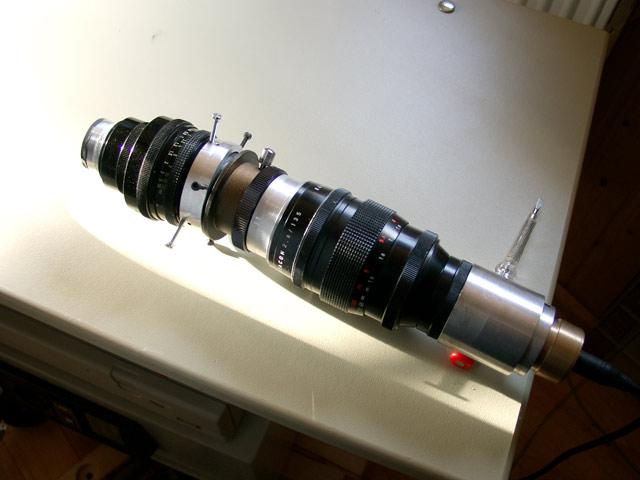
The first spectroscope I used is a very simple one. It is a small transmission grating (Rainbow Optics) that is screwed into the nosepiece of my CCD camera. As it is a blazed grating, it directs most of the light (on the WWW I found values of 66-75% at 5050 angstroms) into one of the first-order spectra. Other technical details: 200 lines per mm, 26mm diameter. The length of the spectrum depends on its separation from the detector surface which is adjustable via suitable extension tubes or nosepieces for the camera. The apparent disadvantage of low resolution spectra which this instrument produces, makes it on the other hand useful for faint deep sky objects, where the few photons do not allow to be spread into long spectra. The target objects have to be point sources like stars and quasars or AGN. Nebulae, Planets, Moon and Sun would require a slit to produce sharp spectral lines. Exceptions are planetary nebulae with emission line spectra like M57, the Ring Nebula. Here the ring is imaged several times at the position of a strong emissionline of the spectrum.

Fig.1: Image and first order
spectrum of Alcor (Spectral type A5V, Mag 3.99).
Characteristic Hydrogen Balmer lines from violet
(left) to red (right side).
Until now I always used it in the convergent beam of the telescope (fast Newtonian 917mm F/4.5), which is not the optimal configuration. Beside the desired 1st-order spectra, the stars also appear as zero order spectra (images) in the CCD recordings. That makes life easier, because you can identify the object of interest without trouble and calibration for wavelength is also not much hassle. Quit strong Fieldcurvature of the spectroscope forces one to refocus on always faint spectral lines (not easy). Stars then become unsharp for a certain amount (Fig.1), which might be precisely handled with help of a computer controlled focuser.
Results
Most noticeable results so far are spectra of two bright supernovae (sn2004dj, sn2004et
![]()
![]() ).
).

Fig.2: Two photo lenses are used in this spectroscope to put the grating into parallel light.
Light enters the slit on the left side. The collimator 50mm f/2.8 forms a parallel beam, that transmits the grating, which is located in the center of the instrument. The dispersed light is then focused by a 135mm f/2.8 lens onto the CCD of the video camera.
Some results follow here.

Fig.3: Low resolution solar spectrum. CCD shows too much sensitivity in blue part.
![]()
![]()
Fig.4:Two types of Mercury (Hg) fluorescent light sources.
Comments welcome, contact:
![]()